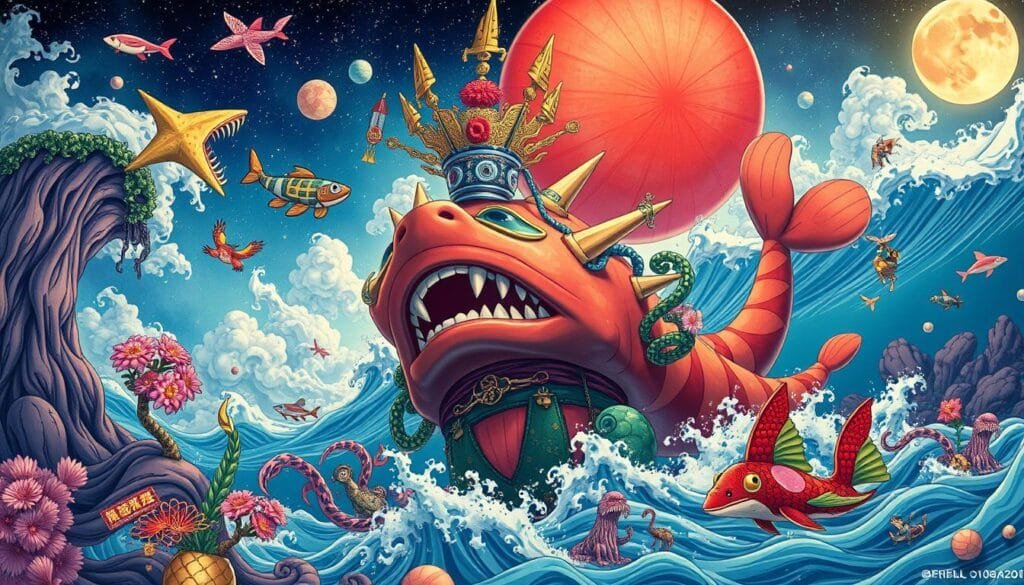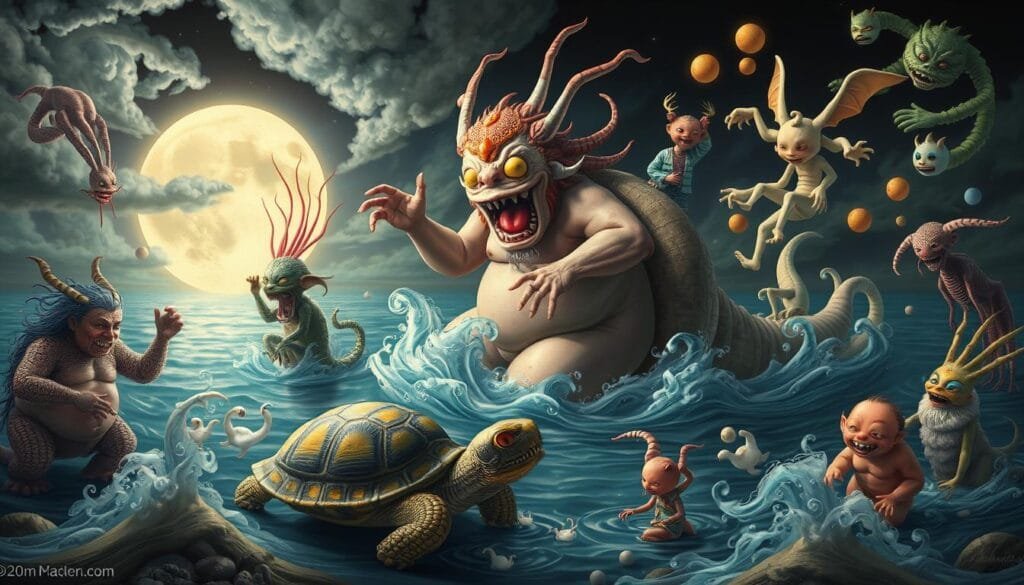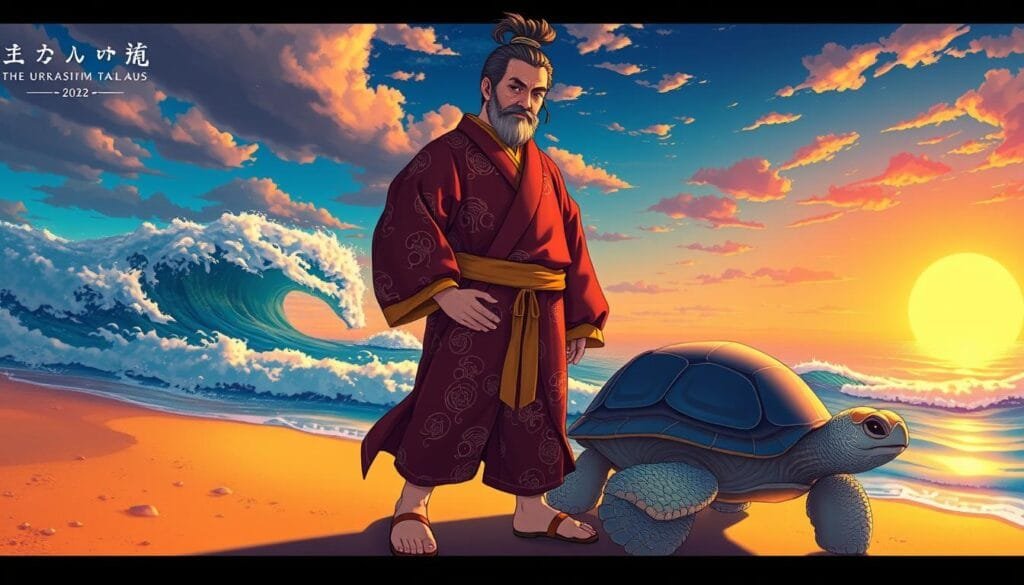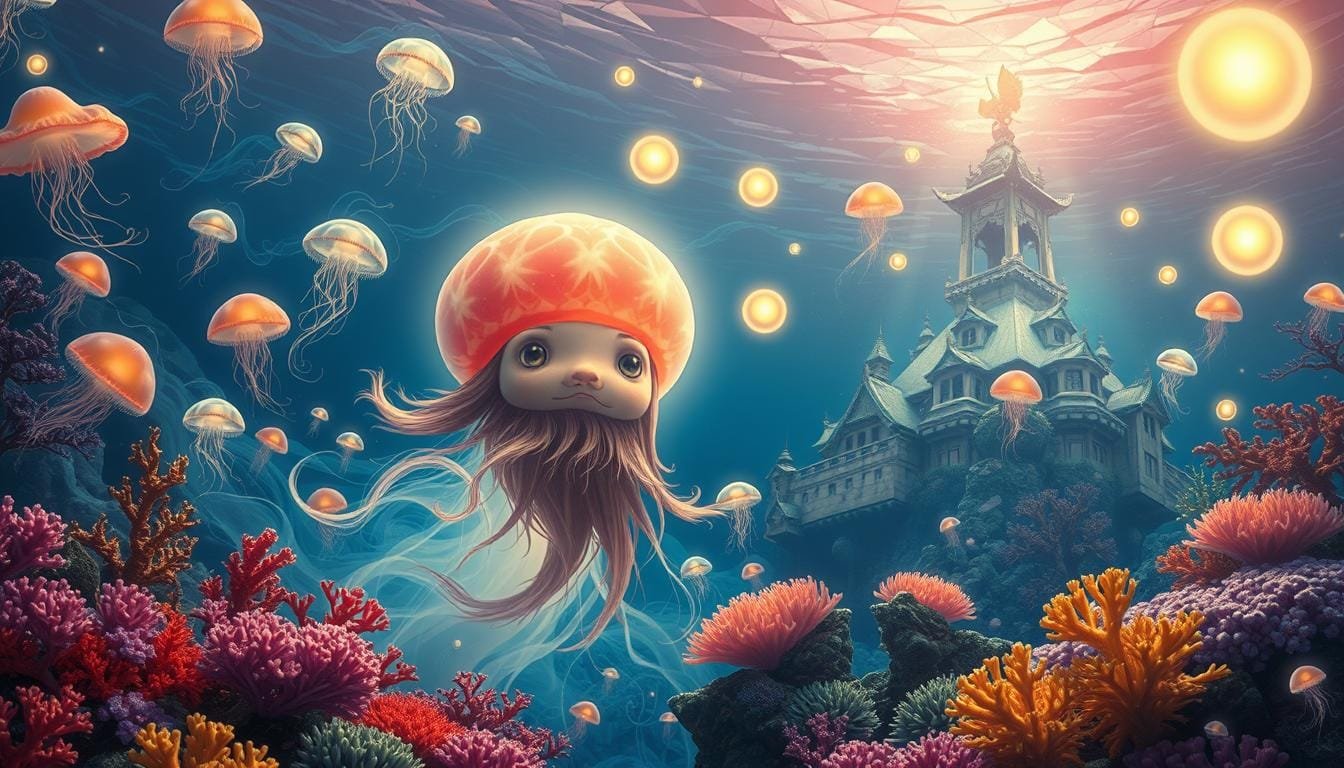Why does an old Japanese story still capture our minds today? When we explore Japanese folklore, we find tales that last through time. They even pop up in today’s pop culture. One of these is Urashima Taro. It’s filled with adventures, myths, and yokai. But, does this story from the Muromachi period still appeal to us now?
Stories like Urashima Taro help define Japan’s culture. They date back to the 14th century. These ancient tales meet today’s media, like books, anime, or games. This mix lets us see how old folklore lives on today.
Key Takeaways
- The tale of Urashima Taro exudes timeless appeal and continues to influence modern pop culture.
- Urashima Taro’s story originates from the Muromachi period, spanning the 14th to 16th centuries.
- Japanese folklore, with its array of yokai, offers rich narratives that transcend historical periods.
- Contemporary media like anime, manga, and video games frequently draw from classic Japanese cultural mythology.
- Understanding the role of yokai within these tales helps enhance our appreciation of Japan’s storytelling traditions.
Introduction to Urashima Taro and His Mythological Roots
Urashima Taro is a well-known character in Japanese mythology. He stands as a symbol of adventure, kindness, and the effects of our actions. His story has been told since the 8th century. It appears in old texts like the “Fudoki” and “Nihon Shoki.” Urashima Taro’s tale lets us dive into Japan’s rich cultural stories and their meanings.
Who is Urashima Taro?
Urashima Taro, a fisherman from Japanese myths, is famous for his good heart and an incredible journey. His story was first written in the 15th century. In this tale, he saves a turtle and visits the magical Dragon Palace. Over time, stories have pictured him riding the turtle to this underwater world. This journey showcases the key beliefs in Japanese culture, tied to Shinto and Buddhism.
Symbolic Elements in Urashima Taro’s Tale
In Urashima Taro’s story, every detail is full of meaning. The turtle he saves represents long life and luck. When he gets a ‘tamatebako’ (a magic box), it leads to a twist where time moves differently for him. This idea of time change appears in over 50 different versions of his story. The way his adventure ties to the four seasons shows the natural cycles of life.
Approximately over 50 variants of the Urashima Tarō tale exist, grouped into four major categories based on similarities.
| Key Element | Symbolism |
|---|---|
| Turtle | Longevity and Good Fortune |
| Tamatebako (Box) | Temptation and Consequence |
| Four Seasons Experience | Nature’s Cyclical Essence |
Urashima Taro’s epic is a key story in Japanese folklore. It shows the rich traditions and lessons from history. By mixing myth with timeless morals, it stays relevant and insightful.
Modern Adaptations of Urashima Taro in Pop Culture
The ancient tale of Urashima Taro, first recorded during the Muromachi Period (1333 – 1573), still captures hearts worldwide. It is shown through various modern platforms. Its lasting cultural importance is seen in schools and art for over 1,200 years.
Literature and Education
Urashima Taro stories are a big part of Japanese literature and schools. Since the 1970s, this story is a main lesson in elementary schools, reaching millions of kids every year. Schools use it to teach important life lessons and share Japan’s cultural treasures.
Urashima Taro is also mentioned in the Nihon Shoki, one of Japan’s oldest historical records. Osamu Dazai’s “Otogizōshi,” published in 1945, made the tale even more valuable in education. It showed how old stories can teach us today.
Art and Visual Media
Artists like Matsuki Heikichi and Utagawa Kuniteru have made captivating artworks of Urashima Taro. These masterpieces highlight the story’s deep influence on Japanese art. The tale’s connection to the four seasons shows Japan’s culture and natural beauty in art. It has inspired artists for many years.
Themes of time and change in the story are also explored in different art forms. This makes Urashima Taro a never-ending source of creativity for artists globally.

Urashima Taro’s stories have a significant impact on education and art. They help us appreciate Japan’s rich culture and storytelling tradition. Through textbooks and stunning art, the tale continues to enchant and teach people everywhere.
Exploring Yokai: What Makes a Mythical Creature?
Yokai are supernatural creatures from Japanese folklore. They range from friendly guardians to scary spirits. Each yokai shows different parts of nature and how we feel.

Yokai stories link the natural world to the supernatural. They are well noted in historic texts like “Pillow Book” and “Shoku Nihongi”. Here, yokai are shown as powerful in both private and society’s life.
In the Edo period, Tsutomu Ema divided yokai into groups. These groups were based on their real shape. They include humans, animals, plants, objects, and natural events. This way of grouping yokai also considers spiritual changes and rebirth. It helps us get a deeper understanding of yokai.
Starting in the Kamakura period, yokai began to appear in art and stories more. This change shows how yokai moved from being feared to becoming entertainment. During the Muromachi period, visual tales about these creatures became very popular.
| Historical Period | Key Developments in Yokai Representation |
|---|---|
| Heian Era | Frequent mentions in literary works, including “Pillow Book” and “Shoku Nihongi.” |
| Edo Period | Yokai characteristics formalized into categories; notable influence on cultural psyche. |
| Kamakura Period Onwards | Emergence of formal visual depictions; growth in public engagement through art and storytelling. |
| Muromachi Period | Yokai as subjects for public entertainment; rise in visual storytelling. |
Yokai have always been part of Japanese culture. They appear in ancient writings like the “Manyoshu” and in today’s anime and manga. Yokai enchant us as scary creatures or protectors. They let us see the rich culture of Japan in a special way.
Are Urashima Taro Yokai In Any Pop Culture References?
Since the 15th century, Urashima Taro’s tale has inspired various cultural forms. It appears in anime, manga, video games, and movies. This ensures the story stays fresh for every generation.

Anime and Manga
Urashima Taro’s story enriches anime and manga. Shows like Gegege no Kitaro and Inuyasha draw from his adventure. These works celebrate the original story and explore themes of change and time’s mysteries.
Video Games and Cinema
Video games often include characters inspired by Urashima Taro. Players get drawn into adventures that make them think. Movies offer new looks at Taro’s emotional and philosophical journey. These versions of Taro’s story make its message echo more broadly.
| Category | Notable Examples |
|---|---|
| Anime and Manga |
|
| Video Games | Narratives featuring Urashima Taro’s mythological journey |
| Cinematic Appearances | Adaptations that explore the philosophical aspects of Taro’s story |
Urashima Taro’s story thrives across media, charming audiences globally. Its roots in ancient folklore make it a lasting symbol. Every new version brings its magic to more people.
Conclusion
The story of Urashima Taro is deeply meaningful in Japanese culture. It began in the 8th century with “Urashima no ko.” Over time, it has become a key part of Japanese elementary education since the 1970s. This tale teaches kindness, the value of time, and respect for life.
The tale’s evolution has significantly influenced modern media. New versions keep the story fresh and relevant. The turtle, a sign of luck and immortality, highlights key Japanese values. The story’s presence in art, literature, and games shows how old tales and modern media mix.
We see Urashima Taro’s cultural impact especially in today’s media. It continues to inspire and offer artistic expression.
The legend of Urashima Taro teaches us the value of preserving folklore. It connects our past with the present and offers timeless lessons. Through Urashima Taro, we learn how stories adapt and remain relevant. They keep our cultural heritage lively for all ages.
FAQ
Who is Urashima Taro?
Urashima Taro is a legendary figure in Japanese folklore. He’s known for being brave and kind. As a fisherman, he saves a turtle, which leads him to a world beneath the sea. His journey teaches us valuable lessons about life.
What are the symbolic elements in Urashima Taro’s tale?
In Urashima Taro’s story, the turtle stands for longevity and luck. The tamatebako, or mysterious box, represents the dangers of giving in to temptation and the effects of our choices.
How has Urashima Taro’s tale influenced literature and education?
Urashima Taro’s tale is a part of school lessons teaching right from wrong. It has influenced many stories, showing its continued charm and its role in teaching morals.
How is Urashima Taro represented in art and visual media?
Urashima Taro’s adventures are depicted in Japanese art by famous artists like Matsuki Heikichi and Utagawa Kuniteru. Their work shows how deeply this folk tale is woven into Japan’s cultural fabric.
What are yokai and their significance in Japanese folklore?
Yokai are mysterious creatures of Japanese legends. Each yokai has its own unique story and characteristics. They link our world to the mystical, showing nature’s mysteries and human feelings.
Are there any modern adaptations of Urashima Taro in anime and manga?
Yes, modern stories in anime and manga like ‘Gegege no Kitaro’ and ‘Inuyasha’ have brought Urashima Taro into today’s world. They’ve kept his story alive, making sure it remains a part of Japan’s modern culture.
How has Urashima Taro influenced video games and cinema?
Video games and movies have embraced Urashima Taro, focusing on his journey’s big changes. This ensures his story stays fresh and continues to inspire people across different forms of media.
